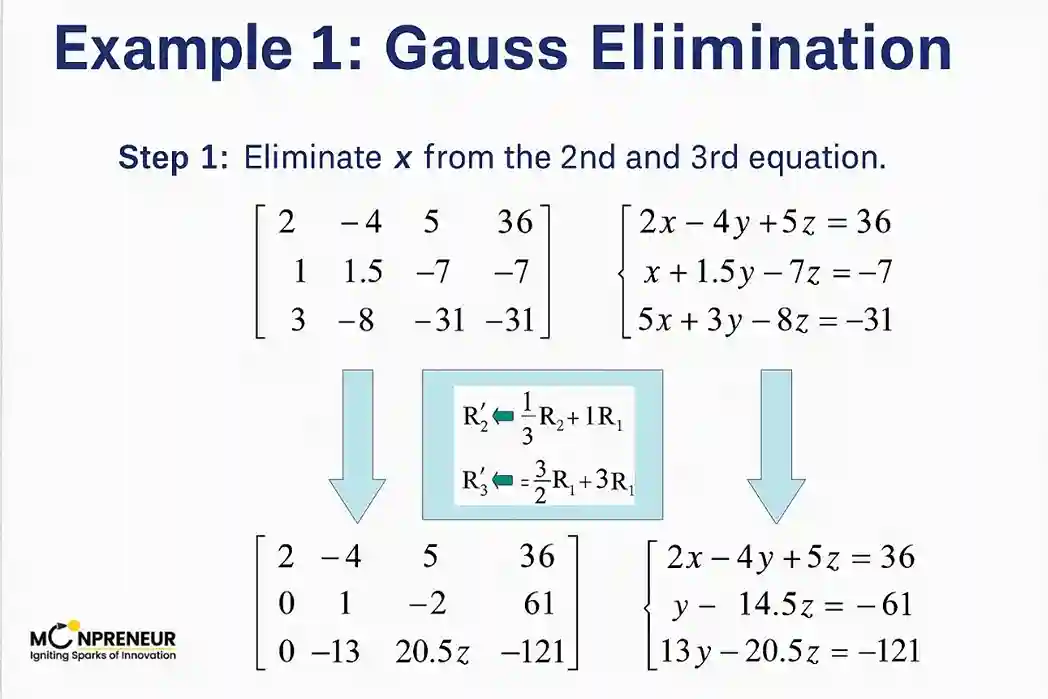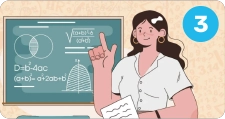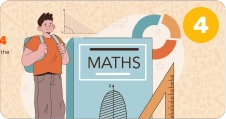Gauss Elimination Method: Definition, Steps, Examples, and FAQs
Introduction
In mathematics, solving a system of linear equations is one of the most important tasks in algebra and applied sciences. A system of linear equations is simply a set of equations involving unknown variables, where each equation is linear. The aim is to determine the values of these unknowns that satisfy all the equations simultaneously.
The Gauss Elimination Method, also called the row reduction method, is one of the most widely used approaches to solve such systems. This method transforms a system of equations into an upper triangular matrix using a series of row operations, making it easier to solve through back substitution. Apart from solving equations, this method is also useful for finding the rank, determinant, and inverse of matrices.
Types of Systems of Linear Equations
| Name of the System | Number of Solutions |
|---|---|
| Consistent Independent System | One unique solution |
| Consistent Dependent System | Infinitely many solutions |
| Inconsistent System | No solution |
What is the Gauss Elimination Method?

The Gauss Elimination Method is a step-by-step procedure to solve systems of linear equations using matrix row operations. It is also known as the row reduction algorithm. The main idea is to convert the given system into an upper triangular form (row echelon form), where all the coefficients below the main diagonal become zero.
Once the triangular form is obtained, the equations are solved using backward substitution.
Additionally, the Gauss Elimination Method can be used to:
– Determine the rank of a matrix.
– Find the determinant of a square matrix.
– Compute the inverse of an invertible matrix.
Elementary Row Operations
To perform Gauss elimination, three types of row operations are allowed:
1. Row Interchange (Swapping): Ri ↔ Rj (e.g., swapping row 2 and row 3)
2. Row Scaling (Multiplication): Ri → kRi, where k ≠ 0
3. Row Replacement (Addition/Subtraction): Ri → Ri + kRj
The final result after these operations is a matrix in row echelon form (REF) or even further into reduced row echelon form (RREF).
Steps of the Gauss Elimination Method
Here’s a structured approach:
1. Write the system in matrix form: AX = B
2. Form the augmented matrix: [A : B]
3. Apply row operations to transform the augmented matrix into an upper triangular form
4. Use back substitution to calculate the unknowns starting from the last equation.
Example of Gauss Elimination Method
Problem:
Solve the following system of equations:
\(\displaystyle \begin{array}{rcl} x + y + z & = & 2 \\ x + 2y + 3z & = & 5 \\ 2x + 3y + 4z & = & 11 \end{array} \)
Step 1: Write in matrix form
\(\displaystyle \left[\begin{array}{ccc|c} 1 & 1 & 1 & 2 \\ 1 & 2 & 3 & 5 \\ 2 & 3 & 4 & 11 \end{array}\right] \)
Step 2: Eliminate coefficients below diagonal
\(\displaystyle R_2 \to R_2 - R_1, \quad R_3 \to R_3 - 2R_1\)
\(\displaystyle \left[\begin{array}{ccc|c} 1 & 1 & 1 & 2 \\ 0 & 1 & 2 & 3 \\ 0 & 1 & 2 & 7 \end{array}\right] \)
Step 3: Further elimination
\(\displaystyle R_3 \to R_3 - R_2\)
\(\displaystyle \left[\begin{array}{ccc|c} 1 & 1 & 1 & 2 \\ 0 & 1 & 2 & 3 \\ 0 & 0 & 0 & 4 \end{array}\right] \)
Step 4: Analyze result
\(\displaystyle 0 = 4 \quad \text{(contradiction)}\)
\(\displaystyle \text{Therefore, the system is inconsistent and has no solution.}\)
Additional Problems for Practice
1) Solve using Gauss Elimination
\(\displaystyle \begin{array}{rcl} x + y + z & = & 9 \\ 2x + 5y + 7z & = & 52 \\ 2x + y - z & = & 0 \end{array} \)
2) Solve using Gauss Elimination
\(\displaystyle \begin{array}{rcl} 4x - 5y & = & -6 \\ 2x - 2y & = & \phantom{-}1 \end{array} \)
3) Solve using Gauss Elimination
\(\displaystyle \begin{array}{rcl} 2x - y + 3z & = & 9 \\ x + y + z & = & 6 \\ x - y + z & = & 2 \end{array} \)
Applications of Gauss Elimination Method
The Gauss Elimination Method is widely used in:
– Engineering: Circuit analysis, mechanical structures.
– Physics: Solving motion equations, force distribution.
– Computer Science: Numerical simulations, computer graphics.
– Mathematics: Matrix computations, eigenvalue problems.
Advantages of Gauss Elimination
– Straightforward step-by-step approach
– Can solve multiple types of problems (equations, determinant, inverse, rank)
– Forms the foundation for advanced numerical algorithms
Limitations of Gauss Elimination
– Time-consuming for large systems
– Prone to rounding errors in numerical computations
– May require pivoting to improve accuracy
Conclusion
The Gauss Elimination Method is one of the most effective techniques for solving systems of linear equations. By systematically reducing equations to triangular form and applying back substitution, it offers a reliable approach for exact solutions. Though it may face challenges with very large systems, it remains an essential tool in mathematics, engineering, and computational sciences.
Want to spark your child’s interest in math and boost their skills? Moonpreneur’s online math curriculum stands out because it engages kids with hands-on lessons, helps them apply math in real-life situations, and makes learning math exciting!
You can opt for our Advanced Math or Vedic Math+Mental Math courses. Our Math Quiz for grades 3rd, 4th, 5th, and 6th helps in further exciting and engaging in mathematics with hands-on lessons.
FAQs on Gauss Elimination Method
Ans: It is used to solve systems of linear equations and also to find determinants, inverses, and rank of matrices.
Ans: Gauss elimination is a direct method because it solves equations in a finite number of steps.
Ans: Write equations in matrix form, reduce to upper triangular form, and solve using back substitution.
Ans: In Gauss Elimination, the matrix is reduced to triangular form, while in Gauss-Jordan Method, it is reduced further to diagonal (reduced row echelon form).
Related Blog:
How to Teach Adjacent Angles to Kids | Simple & Fun Guide
What are Congruent Angles?
Understanding Alternate Interior Angles
What is the Area of Trapezoid?
What is the Area of Parallelogram?
Understanding the Geometry Regents: A Comprehensive Guide
How to Prepare for the Geometry Regents: Study Plans & Practice
The Art of Geometry: How to Draw an Equilateral Triangle Inside a Circle













